Why Is There Water in My Basement & Can I Fix It?

When a homeowner calls us because they have water in their basement, they often say things like, “this hasn’t ever happened before,” or “I don’t understand why water has started coming in now.” We understand the frustration, and we sympathize; a wet basement is NOT the kind of surprise people like!
We also know that most homes suffer from water intrusion at some point. Acculevel is a family-owned and operated company specializing in foundation repairs and waterproofing. Since our start in 1996, we’ve helped more than 30,000 homeowners repair their homes and restore their peace of mind.
In this article, we’re going to help you troubleshoot potential flooding causes, provide some DIY tips to help you reduce water intrusion, and review some tell-tale signs for when you need interior waterproofing.
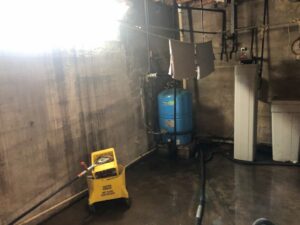
This photo was taken by an Acculevel project advisor, during a free home inspection. The basement floor was covered in several inches of water.
Why Do You Have Water in Your Basement?
When you find water in your basement, your first reaction is probably irritation, because no one enjoys mopping up water in the basement. This is then followed by worry and frustration, maybe with stress or fear mixed in.
You start asking questions, like why is there water on the basement floor? Where did this water come from? Are my basement walls wet?! I don’t see any leaks or foundation cracks! And then the question all homeowners dread: what is this going to cost?
The first thing to tackle is the source of the water. A wet basement doesn’t automatically mean there’s a problem with your foundation. If the water is centered around a floor drain, it could be the result of heavy rains. Significant rainfall in a short time can overwhelm the drainage system in your area. This will cause pipes to be sluggish or even back up, forcing water (or maybe worse!) into your home.
If the water is coming from a leaking pipe or the drain set into your basement floor, you need to call a plumber immediately. Whatever water damage you’re experiencing, it has to be put on hold until you get the water stopped.
But if the source isn’t that easy to diagnose, you need to consider other possibilities.
Can Water Go Through Basement Walls? Or The Basement Floor?
The answer to these questions is yes, it can. Water can seep through any porous material, and this includes the concrete/stone/brick in your foundation. This usually happens because of hydrostatic pressure — a technical term for what happens when the soil is fully saturated with water. The ground can only absorb so much water, and it swells as it does so.
Between soil expansion and rising groundwater, pressure builds against anything blocking the water’s path. This pressure leads to water seepage through your foundation, leaving you with mysteriously wet basement walls or an unwanted indoor pool of basement flooding.

This photo was taken by an Acculeve project advisor during an in-home assessment. Water is seeping through the foundation wall and has created multiple cracks.
Basement Leaks Require An Effective Solution
Your repairs need to be thorough and address both the water seeping inside and collecting outside. If you just mop up the water in the basement and ignore the rest, you’ll be mopping again after the next severe storm. That may not sound too bad to you — especially if you’re not using your basement as a living space or storing important items in it.
But, over time, that hydrostatic pressure forces what were small leaks to widen, becoming major foundation cracks and gaps. This is when serious and expensive problems occur. Crack repairs are not cheap, and once they form they only get worse. Not to mention that chronically wet basements are appealing locations for fungus, biological growth, and bacteria — which aren’t good for you and your family.
Before you stress about having to repair (and fund!) major water damage, let’s evaluate the perimeter of your home. You may be able to correct this situation with some DIY repairs.
How You Can Reduce Water Buildup Around Your Home
We’ve mentioned that there are several factors that contribute to basement water leaks. While some repair options require professional installation, most homeowners are capable of correcting poor drainage that often leads to water in the basement.
Gutters & Downspouts
Let’s start at the top of your home, and work our way down. Grab a ladder, some gloves, and get ready to inspect your home’s guttering. Clean out any pine needles, leaves, or other debris that could be blocking water flow. Once you’ve cleared the clogged gutters, make any necessary repairs including securely attaching any sections that are loose and replacing damaged pieces.
The main purpose of gutters is to collect and direct rainwater. Without them, water would pour over your roof and off the edge, dumping that excess water right next to your home’s foundation. Your downspouts serve the same purpose. These are the extra sections at the end of the guttering, where the water accumulates before emptying into the yard.
Heavy rains, clogged gutters and too-short downspouts will all deposit rainwater next to your home, creating basement water leaks and significant damage to the foundation walls. The best way to prevent this is to keep your gutters clear and functioning, and to extend your downspouts out and away from your home. We recommend that guttering drains at least ten feet from your house.
If you are a DIY fan, you can add downspout extensions yourself. We have an article (with a video demo) that gives you step-by-step instructions here.
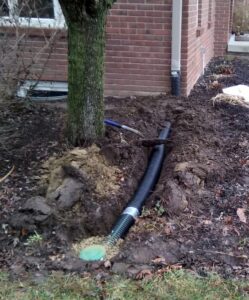
This photo was taken by an Acculevel crew member, while installing a downspout extension at a customer’s home.
Landscaping & Plants
The next thing to check over is the landscaping around your foundation. If you have flower beds or plantings close to your home, make sure they are well-drained. Evaluate any decor located close to your home like a bird bath, large rocks, or other sculptural elements that could direct water towards your foundation.
You should also evaluate any borders or paths around the home to make sure they don’t trap or collect water close to your basement. Railroad ties (or timber that looks like them) are a popular choice because they have a nice rustic look. Unfortunately damp wood like this is a good way to attract insects like termites. While termites can’t hurt the exterior foundation wall, they’ll gladly invade your basement to chew on the wooden components inside. Insect damage is a common cause of sagging floors.
You should also try to avoid planting large trees or shrubs close to your home. Maintaining these plants until they root properly requires frequent heavy watering. And once these plants are well-established, their roots can also dig into your foundation.
Slope
Before you make any major changes to your landscaping, you should also check the slope of your yard. Stand in your driveway or on the sidewalk —somewhere you’ll be safe, but can see the overall shape of your property. The ground around your home should not be completely flat; it should have a gentle slope down and away from the house.This helps encourage natural water drainage.
If the slope has been disrupted or compromised, you’ll need to restore it. This could require bringing in additional soil, moving plants, etc. A good landscaping company can do this for you, as well as help you evaluate the plants and placement around your home.
Signs You May Need Interior Waterproofing
Sometimes it’s obvious you need an interior waterproofing system. Do you regularly have standing water in your basement? Does a heavy rain guarantee that you’ll have a flooded basement? These are clear and easy indications that any homeowner can identify.
But there are other environmental cues that can indicate you need help to manage water intrusion that are less obvious:
- You live in an area with a high water table —near bodies of water or at a lower elevation.
- There is a significant amount of clay in the soil. Clay does not absorb water as effectively as other soil types.
- You have hairline cracks in the foundation. These may be caused by hydrostatic pressure, and can be an entry point for water leaks. Foundation cracks don’t always let in water right away, so don’t be fooled by a lack of moisture.
- Efflorescence (crystals) or water lines on the walls indicate there has been water intrusion, or that moisture is present even if it’s not enough to drip or puddle on the floor.
- Musty odors indicate the area is damp and humid. Like efflorescence, this is a sign of developing basement leaks. Both can lead to mold growth, bacteria development, etc.
What Is Interior Waterproofing?
A waterproofing system requires two major components: a drainage track and a sump pump. These should be installed by professionals to prevent accidental foundation damage. Most homeowners don’t have the skills to break a trench in their basement floor without potentially damaging the foundation footings.
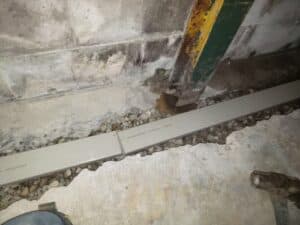
This photo was taken by an Acculevel crew member while installing fast-track water drainage in a customer’s basement.
You also need a professional to determine the right type of drainage to use. This varies, depending on the kind of basement floor you have, the size and condition of your foundation footers, amount of water in the area, etc. The water drainage track is what collects water that enters your home and moves it to a drainage pit. This pit is where your sump pump is located.
How Does A Sump Pump Work?
The sump pump should have a sensor that detects water flow, and it will automatically turn on when needed. A discharge line is routed from the pump through your basement wall and out into your yard at a reasonable distance from your foundation.
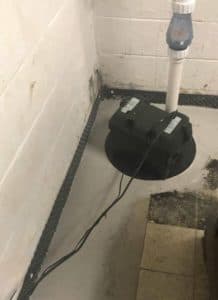
This photo was taken by an Acculevel team member after installing a water drainage system and sump pump.
If you live in an area with a high water table or you experience a significant amount of water in the basement during rainstorms, you may need more than a standard pump. Some homes need a larger model, or more than one pump, and we strongly encourage every sump to include a battery back-up.
At Acculevel, it’s standard practice to include a battery backup with every sump pump. In the Midwest, storms with heavy rain often cause power outages. And when your waterproofing system is actively working to keep your basement dry, the last thing you want is for the pump to stop working.
Have High Humidity And Water In Basement?
Sometimes it’s not enough to manage the water in the basement. You may still have damp or musty air, especially in the warmer months when there’s a significant temperature difference between the outside and inside of your home. Condensation doesn’t just form on a cold glass of tasty beverage — it can form on a brick or concrete foundation.
This is when an expert may recommend installing a whole-house dehumidifier. A good quality dehumidifier will do more than reduce the humidity in your home; it will have a significant impact on your air quality and health.
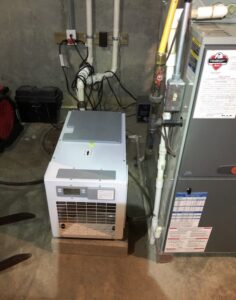
This photo was taken by an Acculevel team member, after installing a whole-home dehumidifier. You don’t have to empty this model; the water line drains into the sump pump.
The ASHRAE (American Society of Heating, Refrigerating and Air-conditioning Engineers) performed a detailed study of homes with significant moisture in the air and determined that the ideal humidity level is around 50%. This is the best level for your home because it’s the least productive environment for bacteria, viruses, fungi, and other irritants to flourish. This is especially beneficial for anyone with asthma, compromised immune systems, or young children. You can learn more about the added value of a dehumidifier in this article.
What’s The Next Step For You?
We hope our suggestions will help you eliminate the water in your basement. If not, it’s time to consider professional basement waterproofing.
Do you live in Indiana or the surrounding areas? If so, call Acculevel at 866-953-1501 or fill out our contact form.
We’ll schedule a free estimate for you with one of our experienced and helpful project advisors. They’ll address your concerns, evaluate your home, and develop a plan that will restore your home’s health and your peace of mind.
If you do not live within our service area, you should find another reputable and reliable contractor who is accredited by the Better Business Bureau. We encourage everyone to use Questions to Ask a Contractor, a guide designed to help homeowners carefully vet contractors before making a purchase or commitment.
Have More Questions?
Use our free basement waterproofing guide! It explores how drainage is installed, which drainage type is best for your home, the costs involved, and other frequently asked questions from homeowners.

